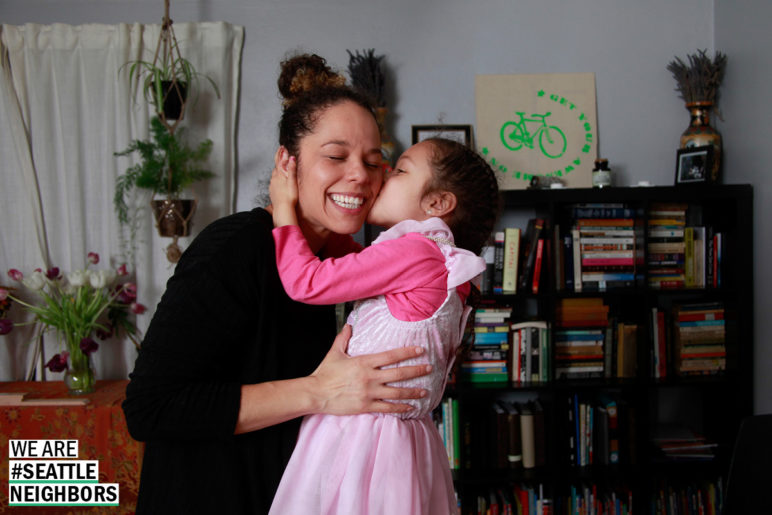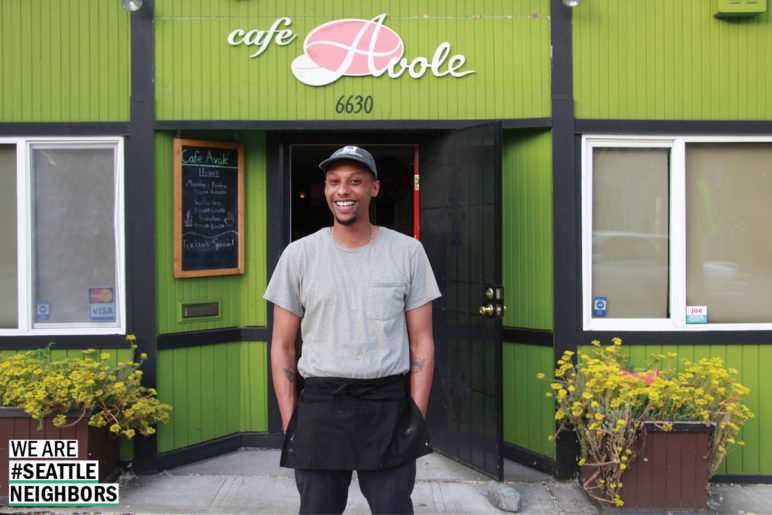Find Seattle Neighbors on Facebook, Instagram, and Twitter.
A woman moves into a van to be able to help pay her daughter’s college tuition. A man converts a convenience store to an Ethiopian-style coffee shop and community hub in Rainier Vista. A single mom makes a new home out of her parents’ garage. And a family of five finds friends and support in a subsidized First Hill apartment complex.
These are just a handful of the experiences Seattleites shared as part of a new photo series and social media project called “Seattle Neighbors.” Locals tell their housing stories, from finding a home after years of homelessness to celebrating new homeownership to moving far away. In the face of a severe housing shortage, residents’ portraits and words about their homes and city say much about the challenge—and the opportunity—for Seattle to serve the housing needs of its many different families and individuals. These are the people who make the city tick, who define the character of our neighborhoods, and who knit together our communities. Their stories illustrate the city’s need for all kinds of homes, in all shapes and sizes, to fit a range of budgets and situations, to suit all our neighbors.
Sightline Institute spearheaded Seattle Neighbors, commissioning two local, professional photojournalists to criss-cross the city capturing the images and words featured in the series. We worked with many partners, from affordable housing developers to community-based organizations, to find the subjects. The result is a series of short photo essays that help refocus Seattle’s housing policy conversation on its real center: the people who live here.
We invite readers to share the photos and graphics* on these pages with your friends and colleagues, especially via social media, and to encourage housing solutions in your own community. Please find Seattle Neighbors on Facebook, Instagram, and Twitter, and preview two of the stories below.
*If you know one of the people featured in Seattle Neighbors, please still use only first names in sharing the stories. Seattle Neighbors photos and graphics are original Sightline Institute work, available under our free use policy for non-commercial use with attribution and not altered or cropped.

Shannon, by Seattle Neighbors, available under our free use policy.
Shannon
When I was making the offer on my house, my agent called and told the owners my story—that I was a single mom trying to buy my first house and create generational wealth for my daughter and give her a future. She convinced them to sell it to me. And they accepted my offer on Mother’s Day. I was visiting my father when I found out and I fell out of the car in his driveway and started crying—I was so happy. We talk all the time about what this house really meant for her, for us.
I don’t know anyone in Seattle who isn’t struggling to live in Seattle. For me, being able to own a home is something I never thought was possible. Buying this house was the confidence I needed to know that I didn’t need dual income or somebody to help me take care of my daughter. It also gave me a lot of security and stability, to the point where I volunteer more, I give a lot more of my time and energy to my community and other organizations. I have a village here. One of my neighbors comes and picks up my daughter and takes her to ballet. I have a whole community of people that I can rely on. Anytime I need anything, I can knock on anyone’s door.

Solomon, by Seattle Neighbors, available under our free use policy.
Solomon
I grew up in Seattle. When I was a kid, I lived in Rainier Vista. Then we moved to North Seattle. I lived in Beacon Hill. And now I live in Tukwila where my mom was able to buy a house. I don’t know if I’ll be able to live here with the income that I make, but I feel like I still live in Seattle. I have family and close friends that lived here. I went to church here. People who have been here 10 years plus are moving out because they are getting priced out. People here are settling anywhere where transportation is accessible. I really like this place. I really like this neighborhood. I want to be here as long as possible.
I’ve always been passionate about starting a coffee shop. It started when I was in college. I ran the mini-mart for about three years, but I really wanted to sell coffee, so I had a coffee cart and I taught myself how to use the espresso machine. We set up a jebena coffee pot and people loved it. It officially became a coffee shop last March and business is way better. The median income of the neighborhood has risen, so that improves the business. But it’s unfortunate that I can’t serve the people that were here when I first opened the shop. They were one of the reasons why I’m here. I don’t care about Starbucks opening down the street. I offer something different than Starbucks. I’m involved in the community and I host events. I host an art show every month. We also do a block party. We need this kind of place to preserve the local Seattle culture.








Catherine Hinrichsen
Nice work, Sightline! Who are the photographers?
– Catherine at SU
Serena Larkin
Thank you, Catherine! They are the very talented Chloe Collyer and Mike Hipple.
Jo
This is the Actual Reality, written here. Thank YOU, all! The photos are great.
Housing is a tangle of jargons; much of it is about architecture and finance, or, both. In the process, the Actual importance of a home and a community gets lost. A home and a community is all there is! That is why I love new Urbanism and Organic food. Poor people enjoyed this style of development and place making for milennia, had these methids for thousands of years, on this planet…. And now, its only for the rich? go figure.
As writer, James Baldwin said, “it is all about the language.” Jargon is language.
Keiko Budech
Thanks, Jo! We’re glad you like it.
Trisa Fisher
I am a single mother of 4 children. I thought my dreams were shattered after losing my job due to a disability. I was recently approved for SSDI. This program gives me hope that my life dreams and hard work can still offer the possibility for
homeownership for myself and future generations to come. Thank you. Trisa
Keiko Budech
Hi Trisa,
Thank you for sharing. We are hoping to launch a second phase to this project where we ask for housing stories and photos of other Seattle neighbors. So stay tuned – we would love to capture your story.